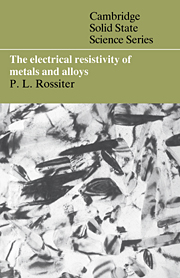Book contents
- Frontmatter
- Contents
- Preface
- 1 Basic concepts
- 2 Atomic configuration of an alloy
- 3 The structure of magnetic materials
- 4 Electrons in simple metals and alloys
- 5 Electrical resistivity of simple metals and alloys
- 6 Non-simple, non-magnetic metals and alloys
- 7 Magnetic and nearly magnetic alloys
- 8 Other phenomena
- Appendices
- References
- Index
1 - Basic concepts
Published online by Cambridge University Press: 07 January 2010
- Frontmatter
- Contents
- Preface
- 1 Basic concepts
- 2 Atomic configuration of an alloy
- 3 The structure of magnetic materials
- 4 Electrons in simple metals and alloys
- 5 Electrical resistivity of simple metals and alloys
- 6 Non-simple, non-magnetic metals and alloys
- 7 Magnetic and nearly magnetic alloys
- 8 Other phenomena
- Appendices
- References
- Index
Summary
Introduction
Understanding the physical processes that determine the electrical resistivity of a concentrated metallic alloy is a daunting task because of the large number of possible contributions that could be involved. In addition to conduction electron scattering from thermally induced atomic displacements (which may depend upon concentration and degree of atomic and magnetic order) there will be other direct contributions from atomic and magnetic disorder, strain and band structure effects. The magnitude of such effects will be influenced by the homogeneity of the microstructure and will depend specifically upon whether the spatial extent or ‘scale ’ of the inhomogeneity is greater or less than the conduction electron mean free path length.
The purpose of this first chapter is to introduce in a general way the relationship between the electrical resistivity and conduction electron scattering and band structure effects. It will be assumed that the reader is familiar with the fundamental concepts of electron waves in solids which have been very adequately considered in a variety of other texts (Ashcroft & Mermin 1976; Coles & Caplin 1976; Harrison 1970; Kittel 1976; Mott & Jones 1936; Blatt 1968; Ziman 1960, 1969, 1972). Other topics which are not specifically considered in detail in this text but which have been considered elsewhere include the electrical properties of pure metals (Meaden 1966; Wiser 1982; Pawlek & Rogalla 1966; Bass 1984; van Vucht et a,. 1985), galvanomagnetic effects (Hurd 1974; Jan 1957).
- Type
- Chapter
- Information
- The Electrical Resistivity of Metals and Alloys , pp. 1 - 29Publisher: Cambridge University PressPrint publication year: 1987
- 3
- Cited by

